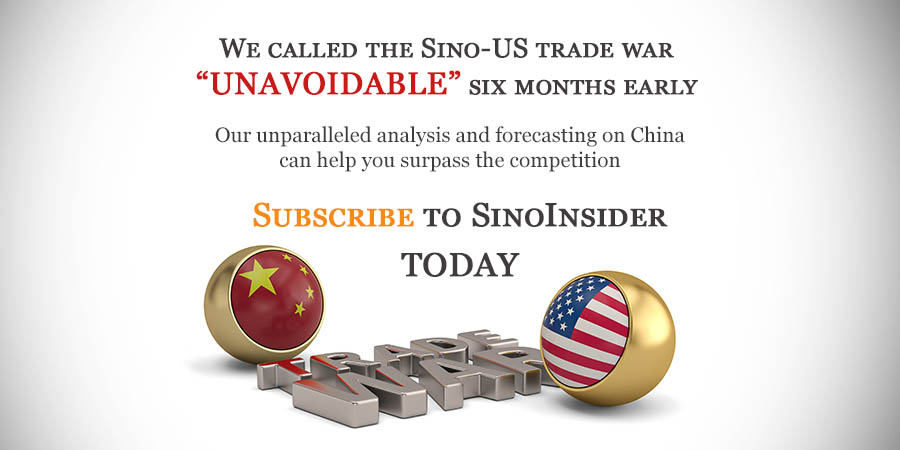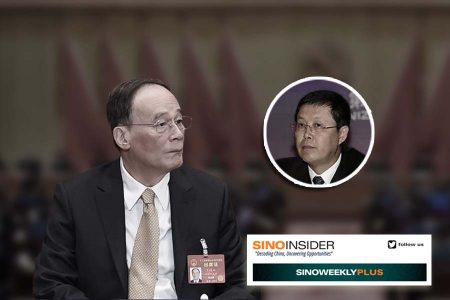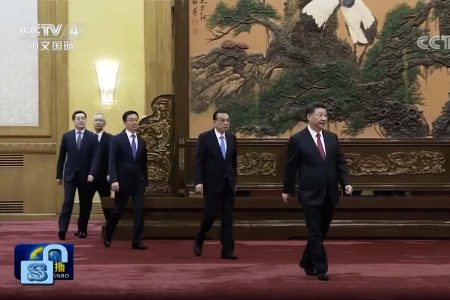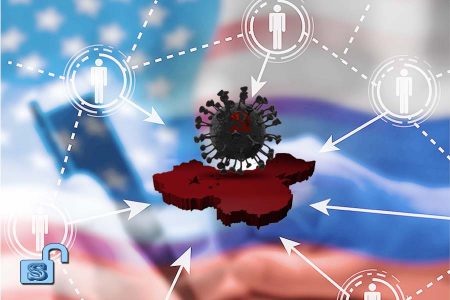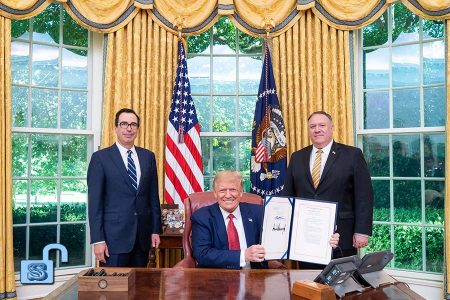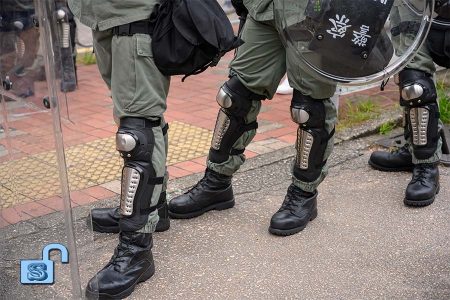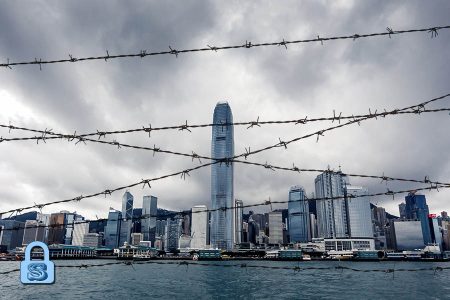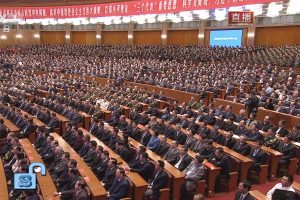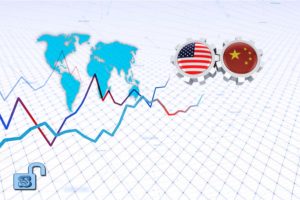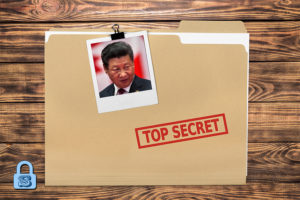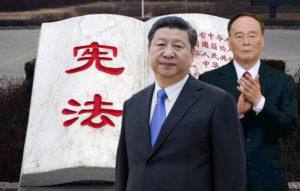In our China 2019 outlook published on Dec. 31, 2018, we made 58 predictions covering seven categories: Politics, the economy, military, society, cross-Strait relations, Sino-U.S. relations, and China and the world.
As of Q2 2019, 41 of our 58 predictions (70.7 percent) have been verified.
Noteworthy forecasts include:
- A Black Swan event for the CCP in the form of mass and prolonged demonstrations in Hong Kong that began in June.
- The United States House of Representative Speaker Nancy Pelosi warned that Congress would reassess whether “Hong Kong is ‘sufficiently autonomous’ under the ‘one country, two systems’ framework.” We predicted that the U.S. could reassess Hong Kong’s status as a free port.
- United States President Donald Trump raised tariff rates on $200 billion worth of Chinese products from 10 percent to 25 percent on May 10. We predicted that the U.S. would raise tariff rates before June.
- Between January to May, China’s national general public budget revenue saw a year-on-year increase of only 3.8% to 8.9919 trillion yuan, the second lowest growth rate for the period in the past 10 years. We predicted that China’s economy will worsen across the board and key economic indicators could hit record lows.
- As we predicted, the People’s Liberation Army did not conduct any large-scale military exercises on the mainland in the first half of 2019.
- Liu Shiyu, an ally of Xi Jinping and former top securities regulator, was purged. We predicted that Xi’s supporters will likely be targeted by his political opponents.
Our forecasting ability and grasp of macro geopolitical trends are built on our research and analysis of CCP elite politics. Party elite politics is upstream of virtually all matters in China today, and at the core of elite politics are factional struggles within the Communist Party.
Businesses, investors, and governments who wish to understand China, make sense of its geopolitics, and anticipate its future directions must track CCP elite politics. Through monitoring elite politics, investors, businesses, and governments can sidestep risks, avoid being blindsided by Black Swan events, and discover hidden opportunities relating to China.
See our China 2019 forecasts and verification in the table below. (Click the arrows to expand details.)
Politics: 5 predictions, 4 verified
1. The CCP factional struggle will escalate. Retired members of the Politburo and its Standing Committee may even be purged. Serving senior officials are also at risk of being investigated.
2. Xi Jinping remains at risk of being targeted by coups from political rivals. Xi’s supporters will likely also be targeted by political opponents if they are responsible for policy failure. VERIFIED
- May:
On May 19, All-China Federation of Supply and Marketing Cooperatives head and former top securities regulator Liu Shiyu “turned himself in” to anti-corruption investigators.
3. Personnel reshuffles should occur frequently throughout the year, with a younger generation of officials being promoted in large numbers to more senior positions. VERIFIED
- January:
In January, two cadres from the younger generation (born around 1970) received exceptional promotions in Guangdong’s Meizhou City and Jiangmen City respectively. Both cadres are on their city Organization Department’s nomenklatura list and could potentially be elevated to higher leadership positions in the future.
- March:
The first quarter of 2019 saw at least 55 personnel changes involving provincial-level officials. Of the 55, five were removed from office; four were transferred to Party Central; three were “parachuted” in from Party Central to the provinces; 10 were transferred to other provinces; and 33 were reshuffled within their province. Meanwhile, four vice ministerial-level officials were purged.
On March 17, the Party Central issued a revised version of regulations used to select and appoint leading cadres to Party and state posts. Article 9 of the revised regulations states that cadres who demonstrate “special excellence” or are needed for “special work requirements” can receive exceptional promotions or hold leadership positions meant for officials with a higher grade level.
On March 25, Guangdong’s Meizhou City handed another exceptional promotion to another cadre on its Organization Department’s nomenklatura list. Meanwhile, Guangdong’s Zhaoqing City gave exceptional promotions to three officials who were born in the seventies.
On March 28, Qin Weizhong, an official from the seventies generation, was appointed deputy governor of Guangdong Province.
- April:
In April, the provincial Political and Legal Affairs Commission heads of Shanghai, Hubei, Inner Mongolia, and Liaoning were replaced.
- May:
In May, the secretary-generals of the provincial Party committees in Fujian, Inner Mongolia, and Hunan were replaced.
- June:
Between June 2 to June 6, the heads of the provincial Organization Department in Ningxi, Heilongjiang, Fujian, Jilin, and Jiangxi were replaced.
4. Xi will likely continue to clean out the political and legal affairs apparatus, the propaganda apparatus, the intelligence apparatus, and the financial system. VERIFIED
- March:
In the first quarter of 2019, there were at least 12 personnel changes involving political and legal affairs cadres at the bureau level and above. Of the 12, two were removed from office, two were “parachuted” in from the Party Central to the provinces, and two were transferred to other provinces.
Also in Q1 2019, at least 30 political and legal affairs cadres at the provincial level and below were either investigated, expelled from the Party, or prosecuted. Among the 30 include former public security vice minister Meng Hongwei, a retired Hebei Public Security Bureau deputy director, three head justices of local courts, three local procuratorate generals, nine local Political and Legal Affairs Commission Party secretaries, and one provincial PLAC boss.
The propaganda apparatus saw several personnel reshuffles in Q1 2019. Two provincial propaganda chiefs were replaced, while eight propaganda apparatus cadres were punished (including four local government propaganda heads). Meanwhile, purged Central Propaganda Department vice minister and internet czar Lu Wei was sentenced to 14 years in prison.
In Q1 2019, three executives in the financial apparatus were investigated and prosecuted.
- April: On April 12, the Tianjin municipal Discipline Inspection Committee announced 17 typical cases of “protective umbrellas,” or local officials who colluded with gangsters. Nine of the 17 cases involved local Political and Legal Affairs Commission officials serving as “protective umbrellas.” Three sub-bureau directors in the Tianjin Public Security Bureau and one public security branch deputy director were found to have been working with gangsters.
- May: On May 20, Yu Siqing, a member of the Party Committee of the Zhangjiajie Public Security Bureau in Hunan Province and the director of the Zhangjiajie Public Security Bureau’s Political Work Department was found to have committed suicide at home.
- Jun:
According to publicly available information, there were a total of 379 cases of Chinese officials being punished in the second quarter of 2019:
- The public security apparatus saw 22 cases, including the punishing of two deputy directors from the Inner Mongolia Public Security Bureau; the corps leader of the Ningxia Autonomous Region’s National Security and Defense Corps in the Public Security Bureau; an inspector in the Heilongjiang Public Security Bureau; and a retired deputy inspector from the Anhui Public Security Bureau;
- The court apparatus saw eight cases, including the punishing of deputy justices in Hainan and Shanxi provincial high court;
- The procuratorial apparatus saw seven cases, including the punishing of two deputy procurators from the Jilin Provincial Procuratorate;
- The propaganda apparatus saw 11 cases, including the punishing of the propaganda chief in Zhongshan, Guangdong Province;
- A total of six secretaries or deputy secretaries from the Political and Legal Affairs Commission at the bureau level and below were punished;
- A total of five bank presidents or vice presidents were punished.On June 20, former Interpol chief and deputy public security minister Meng Hongwei pleaded guilty to charges of bribery and other crimes at the Tianjin No. 1 Intermediate People’s Court.
In the first half of 2019, the CCP’s Central Commission for Discipline Inspection filed a total of 315,000 corruption cases and punished 254,000 cadres, including 20 provincial and ministerial-level officials and 2,000 bureau-level officials.
5. A Black Swan event could imperil the CCP regime. VERIFIED
- Jun:
In June, the people of Hong Kong held several mass demonstrations, marches, and other activities to protest a controversial extradition bill.
Economics: 24 predictions, 19 verified
1. China’s economy will deteriorate across the board. Many key economic indicators could hit record lows. VERIFIED
- February:
According to China’s National Bureau of Statistics data released in February:- Chinese manufacturers sold 1.19 million units of passenger vehicles in February, down 18.5 percent year-on-year and the largest decline in seven years;
- Domestic mobile phone sales plummeted by 19.9 percent in February, a three-year low;
- China’s exports in February fell by 20.7 percent YoY, the largest decline since February 2016;
- China’s Manufacturing Purchasing Managers’ Index (PMI) in February was 49.2, the third consecutive month where PMI fell below the 50 growth mark. China’s PMI in February 2019 was the lowest since February 2016.
- March:
According to China’s National Bureau of Statistics data released in March:- China’s industrial output expanded 5.3 percent in January-February, the slowest since February 2002 (2.7 percent at the time);
- Industrial profits dropped 14 percent in January-February from the same period last year, the steepest since 2011.
- May:
China’s National Bureau of Statistics announced that the profits of industrial enterprises above designated size fell by 3.7 percent from the previous year in April 2019, the largest monthly decline since December 2015.
- June:
On June 14, China’s Ministry of Finance issued fiscal revenue and expenditure data for the period of January to May. In May, the national general public budget revenue was 1.7268 trillion yuan, down 2.06 percent from a year ago and the first negative growth in May in 10 years. From January to May, the national general public budget revenue saw a year-on-year increase of only 3.8% to 8.9919 trillion yuan, the second lowest growth rate for the period in the past 10 years (the slowest growth rate came in 2009, a year rocked by global financial turmoil).
2. The People’s Bank of China could cut its reserve requirements several times and adopt monetary easing policies. VERIFIED
- January:
On Jan. 2, the PBoC “expanded the coverage” of a previous RRR cut, an adjustment that may release up to 400 billion yuan in liquidity.
On Jan. 4, the PBOC announced that it was cutting the RRR by a total of 100 basis points in two stages, freeing 1.5 trillion yuan in liquidity.
From Jan. 14 to Jan. 16, the People’s Bank of China made reverse repurchase agreements on three consecutive days, releasing a total of 850 billion yuan in liquidity.
- May: On May 15, the People’s Bank of China implemented the first of three reserve requirement ratio cuts (May 15, June 17 and July 15) for 1,000 rural commercial banks operating in counties. The RRR cut of 11 percent to 8 percent released about 280 billion yuan for small and medium-sized banks. Between May 27 to May 30, the People’s Bank of China injected a net 430 billion yuan into the banking system via reverse bond repurchase agreements, the largest single week fund dump in over four months.
- June: On June 6, the People’s Bank of China lent 500 billion yuan to financial institutions through its one-year medium-term lending facility. The MLF inject offsets the maturing of previous loans, government bonds, reverse repurchase operations, and other loans. The June 6 MLF injection was 2 billion yuan less than the largest MLF injection in July 2018.As of June 28, there were at least 12 new disclosures of perpetual bonds worth a total of 560 billion yuan.
3. The renminbi will likely drop below the level of 7 yuan to the U.S. dollar.
4. China’s foreign exchange reserves could fall to historically low levels.
5. China’s capital outflows could be severe, and the authorities could tighten capital controls. VERIFIED
- February:
On Feb. 1, the Supreme People’s Court and the Supreme People’s Procuratorate issued new rules that specifically crackdown on illegal underground banks and currency exchanges.
On Feb. 21, the China Banking and Insurance Regulatory Commission announced new measures that target financial and banking institutions’ anti-money laundering and counter-terrorist financing practices. Banks and financial institutions are required to step up anti-money laundering and counter-terrorist financing efforts and log progress on internal information systems to enable better risk management.
- May:
On May 20, the State Administration of Foreign Exchange announced 17 typical cases of market violations where the perpetrators were fined a total of 84.437 million yuan.
During the 2019 Financial Street Forum in China on May 29, Yu Yongding, a member of the Chinese Academy of Social Sciences, accused some Chinese banks for their extreme practices in strengthening capital controls. Yu gave a personal anecdote where he tried to exchange send $20,000 in cash abroad at a bank but was told that he could not do so because he was over 65 years old (Yu is 71 this year) and did not have a “complete set of supporting documents.”
- June:
On June 9, Taiwanese media Liberty Times reported that a large Taiwanese electronics company had tried to remit NT$9 billion from China and was made to pay a huge 10 percent “handling fee” by China’s State Administration of Foreign Exchange.
6. The central government may order more infrastructure projects, but will find it tough selling bonds to fund the projects. VERIFIED
- January:
On Jan. 15, the State Council announced plans to halve the approval time for construction projects nationwide this year.
- February:
On Feb. 27, the Ministry of Finance announced that individual and small- and medium-sized institutional investors would be allowed to purchase local government bonds over the counter at commercial banks. Previously, local government bonds were only sold and traded on the interbank bond market and on the mainland stock exchanges. Also, only banks, securities dealers, hedge funds, and other large financial institutions were allowed to purchase local government bonds.
Commercial banks in six cities, including Beijing, are offering local government bonds over the counter. The minimum purchase amount is 100 yuan.
- March:
Per Li Keqiang’s government work report delivered on March 5, China’s finance ministry will issue 2.15 trillion yuan worth of special government bonds in 2019, the bulk of which will be for infrastructure investment. Additionally, the central government plans to invest 800 billion yuan towards railroad construction and 1.8 trillion yuan for road and water transportation projects this year. Other infrastructure projects, such as water conservancy, municipal works, disaster prevention, and civil and general aviation, will also be carried out in 2019. The central government’s investment budget for 2019 was 577.6 billion yuan, an increase of 40 billion yuan from 2018.
As of March 21, the National Development and Reform Commission has approved 26 major infrastructure projects (including transportation, energy, and water conservancy works) at the total cost of 600 billion yuan.
- June:
On June 10, the CCP General Office and the State Council General Office released a notice on “doing a good job” with issuing local government special bonds and financing project support work. The focus on the notice was to urge local governments to carry out the task of bond issuance and to exempt officials from being held accountable for bond-related matters.
7. The central government will introduce tax reduction measures, but will unlikely trim a proportionate number of government workers. As a result, corporate tax will be subtly raised, not decreased. VERIFIED
- January:
On Jan. 17, the Ministry of Finance and State Administration of Taxation issued a notice to reduce taxes for small and micro-enterprises during the period from Jan. 1 2019 and Dec. 31, 2021. The MoF expects to reduce by 50 percent the tax burden for enterprises with annual taxable income of under 3 million yuan.
- March:
On March 5, Li Keqiang announced in his government work report planned cuts of about 2 trillion yuan in taxes and fees for many industries, as well as a simplification of administrative procedures for firms. The report also unveiled tax cuts for elderly care work units. However, the report does not roll out any measures to reduce government fiscal expenditures, and instead calls on local governments to “lead frugal days” and “find ways to raise funding.”
- January:
On Jan. 14, China’s State Administration of Foreign Exchange announced that the total quota for qualified foreign institutional investors (QFIIs) had been raised from $150 billion to $300 billion.
- February:
On Feb. 20, the State Council decided to cut red tape by eliminating or delegating to lower-level governments a number of administrative approval items. The State Council also decided to halve the review time for construction projects in China to 120 working days within the first half of 2019.
9. China’s property market may see an increase in auctions and more homeowners may have difficulties in paying their mortgages. VERIFIED
- April: According to mainland media reports in April, the cost of some housing in Heilongjiang’s Hegang City had fallen to a low of 348 yuan per square meter.
- June: According to data from Taobao Judicial Auction, a total of 197,000 property projects were auctioned or sold in the first half of 2019, an increase of 25.8% over the same period on 2018. Of the property projects, auctions and sale of residential housing increased by 38.6%; in contrast, auctions of residential housing increased by 25.9% year-on-year over the same period in 2018.
10. Chinese companies may start selling off their property assets to pay off debt. VERIFIED
- April: Haima Automobile, a Chinese listed company, announced on April 23 and May 15 that it is putting up its properties in Shanghai and Haikou City for sale. In total, Haima is looking to sell a total of 401 properties.
- June:
On June 12, Chinese public company Minfeng Special Paper announced plans to sell via auction 36 units of residential housing in Zhejiang’s Jiaxing City. Minfeng began losing money in the fourth quarter of 2018 and saw its net profits drop by 68.09 percent year-on-year. The company’s first quarter report showed that it had total assets of 2.23 billion yuan and a net profit of only 572,000 yuan in Q1 2019, a sharp drop of 91.42 percent year-on-year.
According to a report in the state-run Securities Times, there were 20 property projects (including formal disclosure and pre-disclosure projects) in Beijing that underwent transfer of equity between May 1 to June 14. In contrast, only 12 property projects underwent transfer of equity between April 2018 to April 2019. Also, 15 of the 20 property projects undergoing transfer of equity are funded by state-owned enterprises.
11. Property prices will likely fluctuate drastically (small spurt in prices followed by sharp drops). Property prices in some areas may fall by as much as 30 to 50 percent. VERIFIED
- February:
On Feb. 2, Zhangzhou City’s real estate chamber of commerce publishes a notice on “market chaos” in the city’s property market. The notice says that sales of property at 2,000 yuan per square meter by certain developers severely disrupted the market because it encouraged a low price competition.
On Feb. 27, Xu Jiayin, Evergrande Group’s board chairman, announced 10 percent discounts on Evergrande residential property and 20 percent discounts on Evergrande commercial property during an all-hands marketing meeting. Evergrande staff can apply an additional 5 percent discount plus another 30,000 yuan off on top of the final discounted price (a total price reduction of 36.3 percent).
- March:
On March 4, the Ganxian District Housing and Urban-Rural Development Bureau issued an emergency notice requesting that property developers cease offering “special prices” (i.e. steep discounts). The notice added that property transaction prices for each housing category should not be lower than that of the average transaction price in February for the respective category, otherwise the transaction will not be filed.
In early March, a property company in Zhejiang’s Nanxun District was fined 200,000 yuan for offering a luxury car lottery (Mercedes-Benz) to buyers to promote sales.
- June:
On July 29, the Chinese Academy of Social Sciences released its monthly analysis report on China’s housing market development. The report stated that the prices of housing in core cities has “essentially stopped rising” in June 2019. Housing prices in first-tier cities saw a shift from “structural rising” to an overall decline, and is anticipated to drop further. Housing prices in second-tier cities have “generally stabilized,” while prices in third- and fourth-tier cities “are rising and falling.”
- March:
According to incomplete statistics from property service websites, at least 23 cities across China have relaxed property market regulation policies, including the capital cities of Jinan and Shijiazhuang. Relaxation policies vary from area to area, and include removal of price limits, lifting of restriction on property sales, lowering the threshold for settlement, or lowering property transfer tax on second-hand housing.
- May:
On May 5, the PRC State Council issued an opinion on “establishing and improving the institutional mechanism and policy system for urban and rural integration development.” The opinion proposes to relax hukou restrictions in China (excluding mega cities).
13. A few major property companies could file for bankruptcy. VERIFIED
- June:
On June 14, Yinyi Group, a prominent Chinese property company that focuses on real estate development, filed for bankruptcy reorganization. The conglomerate had a debt of 50 billion yuan. Yinyi Group has been listed among the top 500 enterprises in China for eight consecutive years since 2010. The conglomerate’s property business is listed on the Chinese stock market and ranked among the top 100 property companies in China for 15 consecutive years.
- January:
On Jan. 2, the Shanghai Composite Index closed at 2,465.29 points, or below the 2018 record low of 2486.42 points.
On Jan. 4, both the Shanghai Composite Index and the Shenzhen Component Index fell to four-year lows before recovering (2440.91 points and 7011.33 points respectively).
- April:
Northbound funds, or capital entering Shanghai and Shenzhen through Hong Kong, saw net outflows of 20.9 billion yuan in April, the second-highest outflow in history.
- May:
According to a June 4 report in the Financial Times, China’s stock market saw the withdrawal of $12 billion in foreign funds in April and May, the largest capital outflow since the Shanghai-Hong Kong Stock Connect was implemented in 2014.
- January:
On Jan. 11, the publicly listed Pacific Securities Co. announced that it had set aside 9.72 billion yuan to provide for impairment losses. Of the impairment losses, 97.5 percent involves pledged shares forced liquidation disputes.
- February:
On Feb. 20, public securities company Tianfeng Securities announced the company’s legal situation in 2018. Three of the lawsuits (total litigation amount of 11.71 billion yuan) that Tianfeng faced involve pledged shares forced liquidation disputes.
On Feb. 22, mainland media reported that 11 public securities companies had set aside a total of 49.1 billion yuan to provide for impairment losses in 2018. Of the 49.1 billion yuan, 25.89 billion yuan involved pledged shares forced liquidation disputes.
- June:
More than 60 Chinese companies changed actual controllers (mostly through transfer of equity) in the first half of the year. Most of the companies had majority shareholders who owned pledged shares that were in danger of meltdown.
According to the state-run China Securities Journal, a pledged share meltdown resulted in heavy losses for brokers. Top securities companies like Orient Securities, Western Securities, Northeast Securities, Shanxi Securities, and Sealand Securities saw loses of nearly 1 billion yuan as a result of the meltdown. Orient Securities, which owned the most assets, lost 445 million yuan, of which 90 percent were stock pledged repo transactions.
16. There is a possibility that big Chinese tech companies (not including Baidu, Alibaba, and Tencent) could collapse in 2019. VERIFIED
- January:
On Jan. 11, online property platform pinganfang.com ceased operations.
Near the end of January, online property platform “unicorn” Aiwujiwu closed down.
17. Some financial institutions may go bankrupt. ON TRACK
- February:
On Feb. 28, Xiao Yuanqi, the China Banking and Insurance Regulatory Commission chief risk officer and spokesperson, said that individual financial institutions can pilot bankruptcy mechanisms, but it is preferable for those institutions to undergo merger and reorganization.
- May:
On May 24, the China Banking and Insurance Regulatory Commission took over Inner Mongolia-based Baoshang Bank for a year because it posed serious credit risks.
On May 24, the People’s Bank of China established a depository insurance fund company with registered capital of 10 billion yuan to “bail out” financial institutions that go bankrupt, are forced to close, or have been taken over by the government.
According to a Securities China report on May 29, aside from Baoshang Bank, more than other 10 small banks in China did not publish annual or quarterly reports in 2019.
18. Local debt defaults will increase.
- March:
On March 14, Epson China announced that its Seiko Epson branch in Shenzhen would suspend production until the end of March 2021.
On March 28, Sony announced plans to shut its smartphone plant in Beijing and move production to Thailand.
- May: On May 16, Japanese imaging and electronics company Ricoh announced that it will manufacture copiers bound for the United States in Thailand instead of China.
- June:
Sharp, a Japanese-Taiwanese multinational corporation, announced plans to pull its manufacturing out of China. The company is planning to move its personal computer production line from China to Vietnam, with operations expected to commence in October. Sharp is also considering moving its office equipment production from China to Thailand.
In June, news reports said that Japanese ceramics and electronics manufacturer Kyocera was considering withdrawing its production from mainland China. In August, the company announced that it was moving its U.S.-bound copiers and multifunction printers to Vietnam from China.
According to various news reports, South Korean companies such as Samsung Electronics, Hyundai Motor, KIA Motors, and LG Electronics are making plans to move their production lines out of mainland China.
- February:
During the January-February period, automobile sales in China totaled 14.82 million, or down 14.9 percent from a year ago. Auto sales volume has fallen for nine consecutive months on the mainland.
Also in January-February, industrial profits fell 14 percent year-on-year to 708.10 billion yuan, or the lowest monthly profits since October 2011.
- March:
On March 19, German wholesaler Metro AG started calling for bids for the sale of its China operations.
On March 25, Mister Donut, Japan’s biggest donut chain, closed all 10 of its stores in Shanghai. On the same day, Wal-Mart closed its Taitung store in Qingdao Province.
On March 31, South Korea’s Lotte Group closed its Tianjin department store. Only three Lotte department stores remain in China.
- April:
On April 1, British luxury clothing brand Burberry closed its flagship store in Shanghai’s L’Avenue shopping center. Burberry had closed four stores in Shanghai as of April 1.
On April 15, state media China Net Finance published incomplete statistics which claim that China Resources Vanguard, a Chinese supermarket chain, had closed or entrusted to new owners about 20 stores in Guangdong, Shandong, Beijing, Fujian, Liaoning, and Hubei. Meanwhile, stores in Shenyang’s Guangyi district and Fujian’s Quanzhou City were reportedly preparing to shutter. China Net Finance noted that there appeared to be a trend of China Resources Vanguard supermarkets closing down across the country.
On April 30, China’s National Bureau of Statistics announced that China’s manufacturing Purchasing Managers’ Index fell to 50.1 in April, a decrease from the previous month’s performance and market expectation of 50.5.
In April, China sold 1.54 million general-purpose passenger vehicles, a year-on-year decrease of 16.6%.
- May:
On May 17, Pang Da Automobile Trade, the first Chinese auto dealer to become listed on the A-shares market, filed for bankruptcy reorganization.
In May, China’s manufacturing Purchasing Managers Index was 49.4 percent, or below the expansion 50-mark.
In May, China’s national sales volume of general purpose passenger vehicles totaled 1.4616 million, down 9% year-on-year and 17% from the previous quarter.
- June:
Chinese corporate debt defaults exceeded 66.8 billion yuan in the first half of 2019, the highest in history, according to mainland media reports.
In June, Wal-Mart closed three stores in Shandong’s Jinan City, Jiangsu’s Rugao City, and Zhejiang’s Tongxiang City. In total, Wal-Mart has closed at least 11 stores in the first half of 2019.
On June 23, Carrefour, one of world’s largest hypermarket chains, agreed to sell 80% of its operations on the mainland to Chinese retailer Suning.com for 620 million euros.
According to a June 25 article in Nikkei Asian Review, Takashimaya, a Japanese department store chain, will close its flagship store in Shanghai in August and halt its operations in China.
According to reports by The New York Times and The Wall Street Journal, China’s National Development and Reform Commission held a meeting with over a dozen technology companies to warn them about adhering to the Trump administration’s sanctions on Huawei and other Chinese companies. The NDRC also warned of “consequences” if the tech companies pulled out of China. Some of the tech companies identified include Intel, Qualcomm, ARM, SK Hynix, Microsoft, Samsung, Dell, Nokia, and Cisco.
- January:
On Jan. 7, a protest broke out in Shenzhen between workers and public security officials after a cell phone case supplier who was shutting down retrenched over 3,000 workers. The protest was launched over compensation issues.
In January, overseas Chinese language media reported that Hyundai laid off nearly 2,000 workers from its Beijing factories. Hyundai’s Beijing factories currently employ over 6,000 workers.
- February:
On Feb. 27, The New York Times reported that Ford’s joint venture in Chongqing had quietly started to lay off 20,000 workers.
- March:
On March 22, Chinese delivery company Guotong Express placed 50,000 workers on leave after reporting that it had sustained heavy losses.
- April: On April 9, tech news site The Information reported that Chinese e-commerce giant JD.com Inc was carrying out massive layoffs. JD.com could cut over 12,000 jobs, or 8 percent of its 150,000 workforce.
- May:
On May 13, Beijing held a national teleconference meeting on employment and entrepreneurship opportunities for high school and college graduates. Premier Li Keqiang participated in the meeting and gave instructions. The meeting stressed that the bottomline of mass unemployment should not be breached in the face of a very complicated and grim situation in China.
On May 22, the State Council General Office issued a notice about establishing an employment work leading group with vice premier Hu Chunhua at the helm. According to news reports, U.S. database and cloud computing company Oracle is planning to lay off more than 900 people (about 60% of its total employees) from its mainland China operations. Several employees believe that the layoffs are a step towards completely shutting down research and development operations in China.
- January:
In January, China’s Agricultural Product Price Index 200 was reported at 109.26 (YoY +2.74%, MoM +4.04%).
On Jan. 31, cumulative purchases of autumn grain from China’s main agricultural areas decreased by 17.92 million tons (-12.82%).
- February:
On Feb. 19, the CCP Central Committee and the State Council jointly issued the first work document of the year. Ensuring food supply was a key area of focus: Grain planting area was to be kept stable at 1.65 billion mu; arable land must be kept steady at above the “red line” of 1.8 billion mu; a permanent basic arable land special protection system must be fully implemented; and permanent basics arable land must be kept at above 1.546 billion mu.
On Feb. 27, vice premier Han Zheng chaired a national teleconference on grain reserve management and food security. During the teleconference, Han said that all regions and departments must attach great importance to grain stockpile management and “eliminate hidden dangers.”
On Feb. 28, cumulative purchases of autumn grain from China’s main agricultural areas decreased by 10.7 million tons (-6.59%).
In February, China’s Agricultural Product Price Index 200 was reported at 116.46 (YoY +1.23%, MoM 6.59%). On Feb. 15, China’s Agricultural Product Price Index 200 was reported at 117.42, a record high.
- March:
On March 5, Li Keqiang said in his government work report that the Chinese regime needs to keep food supply stable in 2019 and add another 80 million mu of quality arable land.
On March 20, cumulative purchases of autumn grain from China’s main agricultural areas decreased by 60,000 tons. This is a distinct abnormality in comparing grain purchases with that in February. We believe that this abnormality is the result of the CCP purchasing large quantities of U.S. food during the period of Sino-U.S. trade talks.
In March, China’s Agricultural Product Price Index 200 was reported at 116.23 (YoY +8.53%, MoM -0.20%).
- April:
According to mainland media, the price of fruit in China had been rising sharply in recent months. Some varieties of fruit saw price increases by as much as 78 percent as compared to the same period in 2018.
According to data released by China’s National Bureau of Statistics, the consumer price index rose by 2.5 percent year-on-year in April, a six-month high. The price of vegetables, pork, and fruit rose by 17.4%, 14.4%, and 11.9% respectively.
- May:
In May, China’s Ministry of Agriculture and Rural Affairs information center released data showing that the average monthly price of lean pork in 16 provincial cities was 20.26 yuan per kilogram, up 0.3% from the previous month and up 43.7% year-on-year.
- June:
On June 12, China’s National Bureau of Statistics released data showing that the consumer price index steadily increased from 1.5 percent year-on-year in February to 2.7 percent year-on-year in May. Also in May, food prices grew 7.7 percent year-on-year while non-food prices rose by 1.6 percent from the previous year.
In June, China’s Ministry of Agriculture and Rural Affairs information center released data showing that the average monthly price of lean pork in 16 provincial cities was 22.89 yuan per kilogram, up 13% from the previous month and up 50% year-on-year.
- January:
Shanghai gold benchmark price:
AM price:
Jan. 1: ¥285.11
Jan. 31: ¥287.23
Growth (for the month of January): +0.74%
PM price:
Jan. 1: ¥285.82
Jan. 31: ¥287.47
Growth: +0.58%
International gold & silver price:
Gold:
Jan. 1: $1280.08 per ounce
Jan. 31: $1321.05 per ounce
Growth (for the month of January): +3.24%
Silver:
Jan. 1: $15.75
Jan. 31: $15.91
Growth (for the month of January): +1.01%
- February:
Shanghai gold benchmark price:
AM price:
Feb. 28: ¥285.11
Growth (Jan. 1 to Feb. 28): +0.06%
PM price:
Feb. 28: ¥285.82
Growth (Jan. 1 to Feb. 28): -0.38%
International gold & silver price:
Gold:
Feb. 28: $1314.39
Growth (Jan. 1 to Feb. 28): +2.68%
Silver:
Feb. 28: $15.21
Growth (Jan. 1 to Feb. 28): -3.43%
- March:
Shanghai gold benchmark price:
AM price:
March 31: ¥282.12
Growth (Jan. 1 to March 31): -1.05%
PM price:
March 31: ¥281.75
Growth (Jan. 1 to March 31): -1.42%
International gold & silver price:
Gold:
March 31: $1,291.85
Growth (Jan. 1 to March 31): +0.92%
Silver:
March 31: $15.10
Growth (Jan. 1 to March 31): -4.13%
- April:
Shanghai gold benchmark price:
AM price:
April 29: ¥280.48
Growth (January to April): -1.62%
PM price:
April 29: ¥280.69
Growth (January to April): -1.79%
International gold & silver price:
Gold:
April 30: $1283.15
Growth (January to April): +0.24%
Silver:
April 29: $14.69
Growth (January to April): -6.73%
- May:
Shanghai gold benchmark price:AM price:June 30: ¥308.96
Growth (January to June): +8.73%
PM price:
June 30: ¥307.66
Growth (January to June): +7.64%
International gold & silver price:
Gold:
June 30: $139,184
Growth (January to June): +8.73%
On June 24, the price of gold hit a six-year high and saw an 11% price increase from Jan. 1.
Silver:
June 30: $15.39
Growth (January to June): -2.29%
- June:
Shanghai gold benchmark price:AM price:June 30: ¥308.96
Growth (January to June): +8.73%
PM price:
June 30: ¥307.66
Growth (January to June): +7.64%
International gold & silver price:
Gold:
June 30: $139,184
Growth (January to June): +8.73%
On June 24, the price of gold hit a six-year high and saw an 11% price increase from Jan. 1.
Silver:
June 30: $15.39
Growth (January to June): -2.29%
24. If Sino-U.S. relations improve, there is a chance that China’s economy will improve as well. Changes, however, may not be immediately noticeable.
Military: 5 predictions, 3 verified
1. Xi Jinping will continue to frequently reshuffle top military officials and commanders. VERIFIED
- January:
On Jan. 1, Xi Jinping appointed Southern Theater Command Joint Operation Department director Xu Liangcai as commander of the People’s Liberation Army in Macau.
On Jan. 8, Major General Zhao Ruibao, the PLA Rocket Force political commissar, was promoted to deputy political commissar and director of the Western Theater Command’s political work department.
On Jan. 12, Major General Chen Zhaoming, the former PLA Logistic Support Force chief of staff, was promoted to commander of the Henan Military District.
On Jan. 13, Major General Jiang Ping, the former deputy director of the PLA Air Force political work department, was promoted to political commissar of the Western Theater Command.
On Jan. 14, Major General Yuan Huazhi, the first political commissar of the PLA Navy Marine Corps, was promoted to air force political commissar of the Eastern Theater Command. Meanwhile, Major General Hong Jiangqiang, the former deputy commander of the 79th Group Army, was promoted to group army commander.
- February:
On Feb. 21, former CMC Chief of Joint Staff Fang Fenghui was sentenced to life imprisonment on corruption charges.
- April: People’s Armed Police political commissar Wei Shusheng was transferred to the Central Theater Command to serve as the theater’s political commissar in April, according to publicly available information.
- June:
According to publicly available information:
- Yu Yonghong, the political commissar of the 79th Army Group, was transferred to the PLA Ground Force discipline inspection commission to serve as its secretary.
- Major General Xue Hongwei, the former political commissar of the PLA Aviation University Air Force, replaced Major General Yi Jianhui as secretary of the Central Theater Command Air Force discipline inspection commission.
- Major General Chen Jian, the former deputy political commissar of the Wuhan Joint Logistic Support Base, was transferred to the PLA Joint Logistic Support Force political work department to serve as its deputy director.
2. A few PLA generals could be publicly investigated.
3. The PLA will strengthen its presence in the South China Sea. VERIFIED
- June:
Between the end of June to July 3, the PLA conducted a series of missile tests in a disputed part of the South China Sea. At least one missile splashed down into the sea.
4. The CCP’s military expansionism will be impeded by a worsening economy and the international isolation of China.
5. Barring major incidents in the CCP factional struggle, the scale and frequency of domestic military drills will likely be lowered in 2019. VERIFIED
- June:
In the first half of 2019, the People’s Liberation Army did not conduct any large-scale military exercises on the mainland.
Society: 4 predictions, 3 verified
- January:
On Jan. 7, scuffles broke out between protesting workers and public security officials in Shenzhen over compensation issues after a cell phone case supplier retrenched over 3,000 workers.
- March:
On March 11, thousands of high school students from Hubei’s Tianmen City took to the streets in protest. Some of the students were injured after getting into scuffles with the police.
On March 23 and March 24, thousands of employees from Tianjin Iron Works in Hebei’s Shexian County staged demonstrations. Thousands of police were mobilized to suppress the protests.
- June:
In June, villagers from Guangdong’s Yunfu County and Yunan County carried out a multi-day protest against the local authorities who were preparing to build a waste incineration plant. As many as 20,000 people took to the streets on June 22.
- February:
The CCP launches a countrywide campaign to combat “indiscriminate banqueting.” According to overseas Chinese language media reports, there have been incidents where local governments beat up and robbed civilian banqueters.
- March:
At the start of March, Guangdong Guangya Middle School was exposed for buying 3,500 GPS smart bracelets for its students.
On March 20, Chongqing Normal University released an official document which noted that Tang Yun, an associate professor at the college, was stripped of his rank and teaching credentials after students reported on him for comments he made in class.
On March 26, Xu Zhangrun, a Tsinghua University professor, was placed under suspension. Last year, Xu published several articles that criticized Xi Jinping’s policies.
Near the end of March, several universities in China issued urgent instructions for students to register their social media accounts.
- April:
On April 8, Sina Weibo administrators announced that a batch of Weibo accounts had been suspended or closed because they “released harmful information about current affairs.” The administrators also said that they would announce specific disciplinary measures on a weekly basis. Many mainland social media thought leaders were affected by Weibo’s crackdown.
- May:
According to Minghui.org, a clearinghouse of information about the persecution of Falun Gong, the month of May saw:- At least 341 practitioners detained by the authorities (124 were later set free). Forty of the detained practitioners were above the age of 65 and the oldest was 82-years-old;
- 302 practitioners were harassed by security forces at home;
- 66 practitioners were convicted;
- 69 practitioners were sentenced in illegal court hearings;
- 5 practitioners were sent to forced brainwashing sessions;
- 28 practitioners were arrested by the authorities;
- 4 practitioners were persecuted to death;
- 5 practitioners were forced out of their homes;
- 2 practitioners were sent to psychiatric hospitals for persecution.
- June:
On June 12, the PRC State Council announced at an executive meeting chaired by Li Keqiang that China will step up the building of a social credit system by introducing new market regulatory measures.
On June 13, the Cyberspace Administration of China released “Draft Measures on Security Assessment of Cross-Border Transfer of Personal Information” for public comment. The draft measure is aimed at gathering and tightening control of personal information.
3. Indiscriminate murders and “revenge on society” violent incidents could become more frequent and severe in 2019 as compared to 2018. VERIFIED
- January:
On Jan. 8, a 49-year-old janitor at Beijing Xicheng Elementary School attacked students with a hammer to vent his frustrations with society. Twenty students were injured and three were severely wounded.
On Jan. 14, a man in Fujian’s Fuzhou City went on a knife rampage, killing one and injuring 19. On the same day, a man in Guangdong’s Humen Town killed one and injured eight in a knife attack.
On Jan. 24, a slashing incident in Anhui’s Suzhou City left one child dead and another three injured.
On Jan. 25, a cancer-stricken man set off a series of explosions in Changchun’s Wanda Plaza to “take revenge on society.” The explosions killed one person and injured another.
- February:
On Feb. 5, a knife-wielding man killed eight and wounded seven in Gansu’s Huining County.
On Feb. 21, a local of Jiangxi’s Ji’an City wounded 11 people in a slashing incident. Ten of the 11 wounded were school students.
- March:
On March 14, a student from Hebei’s Tangshan City slashed a primary school student who was on the way to school. Other students were also injured in the knife attack.
On March 22, a man went on a driving rampage in Hubei’s Zaoyang City, knocking down pedestrians and killing at least seven people.
On March 28, a suicide bombing incident at a police station in Liaoning’s Heping District killed one and injured three.
- Apri:
On April 3, a man went on a slashing spree in an elementary school in Ningyuan Country, Hunan Province. The slashing incident left two dead and two injured.
4. Aside from the African swine flu, other forms of contagious diseases could break out on the mainland. The authorities, however, will only divulge more information about a disease outbreak when the situation becomes too problematic to cover up.
Cross-Strait relations: 3 predictions, 2 verified
- January:
On Jan. 2, Xi Jinping said in his “Message to Compatriots in Taiwan” that “Taiwan will be guaranteed lasting peace after peaceful reunification.”
- February:
On Feb. 27, An Fengshan, the State Council Taiwan Affairs Office spokesman, said during a press conference that “one country, two systems” remains the CCP’s “basic guideline” for resolving the Taiwan issue. An added that Taiwan will be guaranteed “peace and security” after “peaceful reunification.”
- March:
On March 5, Major General Wang Shaoxing said in an interview that “one country, two systems” remains the “best plan” to resolve cross-strait reunification. Wang, who is also a CPPCC member, said that the Taiwanese people will be guaranteed “10 privileges” (including the privilege of retaining a military) should the ROC government opt for reunification under “one country, two systems.”
- April:
In April, several Facebook group administrators in Taiwan reported that they had received private messages inquiring about the sale of group administration rights. The administrators suspected that some people were actively trying to buy access to manage Facebook groups. Taiwanese Facebook group administrators also noted that some Facebook ads and employment websites were searching for people who “support cross-strait reunification,” a clear recruitment for PRC goals. Many Taiwanese suspect that the CCP’s “50-cent army” is presently paving the way to influence and interfere in Taiwan’s 2020 presidential election.
- January:
On Jan. 22 and Jan. 24, the PLA Air Force dispatched several jet fighters to circle around Taiwan.
- March:
On March 31, two PLAAF fighter jets crossed the median line, or the border within the waters of the Taiwan Strait. The incident triggered a 10-minute standoff between fighters from both sides.
- April:
On April 15, the PRC deployed 24 military aircraft and five naval vessels in a drill near Taiwan.
On April 17, Chinese fishing boats clashed with Taiwanese coast guards. The Chinese fishermen threw rocks at the Taiwanese coast guard ship, and the ship fired stun grenades back at the fishing boats.
- June:
On June 10, a six-ship PLA Navy flotilla of which the Liaoning aircraft carrier was a part of appeared in the East China Sea.
On the morning of June 11, the flotilla crossed the Miyako Strait. After approaching the waters of Guam, the flotilla neared southern Philippines and entered the waters of the Nansha Islands in the South China Sea.
On June 24, a PLA Navy flotilla which included the Liaoning aircraft carrier sailed into the region near the Dongsha Islands. On the morning of June 25, the flotilla sailed through the Taiwan Strait before returning to the naval base in Qingdao.
Sino-U.S. relations: 12 predictions, 8 verified
1. The U.S. and China could hold a high-level summit in February. Xi Jinping may visit the United States. ON TRACK
- February:
From Feb. 14 to Feb. 15, China and the U.S. held the sixth round of high-level trade negotiations in Beijing.
From Feb. 21 to Feb. 22, China and America held the seventh round of high-level trade talks in Washington. According to news reports at the time, both sides were discussing a meeting between President Trump and Xi Jinping in Florida in late March.
2. China and the U.S. could reach a framework agreement which Washington finds acceptable by the end of the 90-day trade negotiation period in March. Further Sino-U.S. trade talks will be held.
3. The U.S. may raise tariff rates on $200 billion worth of Chinese goods from 10 percent to 25 percent before June. President Donald Trump may order 25 percent tariffs on an additional $267 billion worth of Chinese goods in the second half of 2019. VERIFIED
- May:
On May 5, President Trump tweeted that the U.S. will raise tariffs on $200 billion worth of Chinese goods from 10 percent to 25 percent. Trump also announced plans to impose 25 percent tariffs on $325 billion worth of additional Chinese products. On May 10, the U.S. formally raised the rate on existing tariffs to 25 percent, and began collecting the higher tariffs on May 31, U.S. time.
- June:
On June 25, the U.S. government concluded hearings on new tariffs on $300 billion worth of additional Chinese goods.
- February:
On Feb. 5, the U.S. warned its European allies not to use Chinese 5G equipment.
On Feb. 11, the U.S. warned Germany not to use “untrusted vendors” like Huawei and other Chinese equipment makers in building 5G networks.
- March:
On March 22, U.S. Secretary of State Mike Pompeo warns Israel that it risks losing intelligence cooperation with America if it does not restrict its ties with China.
- April:
On April 2, a U.S. State Department spokesman told Reuters that the United States will not send high-level officials to attend the PRC’s second Belt and Road summit that month.
On April 3, Foreign Policy magazine reported that U.S. National Security Advisor John Bolton is leading a campaign to contain the PRC’s expanding influence in the United Nations and other international organizations.
On April 4, U.S. Secretary of State Mike Pompeo called on NATO allies to “confront emerging threats” like “Chinese strategic competition, including technology and 5G, and many other issues.
On April 4, The Wall Street Journal reported that the U.S. is expanding its military presence on strategically important Pacific islands as part of a strategy to grow relations and impede PRC expansion in the Pacific.
On April 9, The Wall Street Journal reported that the U.S. State Department and other government agencies are helping countries like Myanmar push back on multibillion-dollar deals in a new
On April 12, U.S. Secretary of State Mike Pompeo said during a press conference in Chile that the PRC’s trade activities are often closely linked to its national security goals. He also warned against the PRC’s “predatory lending practices.”
On April 17, Randall G. Schriver, assistant secretary of defence for Indo-Pacific security affairs at the US Department of Defence, said that China and the U.S. are engaged in an “ideological battle” during conference on US-China-European Union relations sponsored by the Hudson Institute.
- May:
On May 6, U.S. Secretary of State Mike Pompeo said that the PRC is behaving aggressively in the Arctic at a conference in Finland. “The Pentagon warned just last week that China could use its civilian research presence in the Arctic to strengthen its military presence, including by deploying submarines to the region as a deterrent against nuclear attacks,” he said. “We need to examine these activities closely, and keep the experience of other nations in mind. China’s pattern of aggressive behavior elsewhere will inform how it treats the Arctic.”
On May 8, U.S. Secretary of States Mike Pompeo warned the United Kingdom not to go “wobbly” after Britain allowed Huawei a restricted role in building parts of its 5G network. “In China, we face a new kind of challenge; an authoritarian regime that’s integrated economically into the West in ways that the Soviet Union never was,” he said. “This is exactly what China wants; they want to divide Western alliances through bits and bytes, not bullets and bombs.”
On May 9, a U.S. guided missile destroyer, a Japanese aircraft carrier, two Indian naval ships, and a Philippine patrol vessel conducted drills in the South China Sea.
On May 14, Xi Jinping said at the Conference on Dialogue of Asian Civilizations in Beijing that, “To think that one’s own race and civilization are superior to others, and to insist on transforming or even replacing other civilizations, is foolish in understanding and disastrous in practice.” Xi appeared to be pushing back against U.S. international pressure with his remarks.
On May 28, U.S. Secretary of State Mike Pompeo said in an interview on Fox Business Network that “the whole work is waking up” to concerns about China. “And so we spend a great deal of time making sure that we have the right strategy, that we have resourced it properly, but also in sharing it with our allies in the region – Singapore, Vietnam, all of these countries in East Asia and Southeast Asia – ensuring that they too understand these risks so that they can be part of the team, part of the alliance that pushes back against this Chinese threat,” he said.
5. The U.S. could reassess Hong Kong’s status as a free port, and even consider reclassifying Hong Kong as part of the same customs territory as mainland China. VERIFIED
- June:
On June 10, a U.S. Department of State spokesperson made the following remarks on the Hong Kong situation: “Last month the Secretary met with a delegation of pro-democracy leaders from Hong Kong to discuss their broad reservations about the extradition proposal. We believe that any amendments to the fugitive offenders ordinance should be pursued with great care and in full consultation with a broad range of local and international stakeholders who may be affected by the amendments. The continued erosion of the ‘One Country, Two Systems’ framework puts at risk Hong Kong’s long-established special status in international affairs.”
On June 11, U.S. House of Representative Speaker Nancy Pelosi said released a statement on Hong Kong. “The extradition bill imperils the strong U.S.-Hong Kong relationship that has flourished for two decades. If it passes, the Congress has no choice but to reassess whether Hong Kong is ‘sufficiently autonomous’ under the ‘one country, two systems’ framework,” the statement read.
6. The CCP could downplay overt efforts to influence and interfere in American politics and society. However, the CCP could step up the scale and speed of covert subversion activities like espionage and cyber hacking. VERIFIED
- January:
On Jan. 31, the FBI arrested a Chinese engineer who worked for Apple just before he was scheduled to fly to China. The engineer was charged with stealing secret material on Apple’s self-driving cars.
- February:
On Feb. 18, The New York Times reported that Iranian and Chinese hackers have been aggressively attacking U.S. businesses and government agencies, citing analysts at the National Security Agency and the private security firm FireEye. The Times noted that Boeing, General Electric Aviation and T-Mobile were among the recent targets of China’s industrial espionage attempts.
- March:
On March 12, The Wall Street Journal reported that the U.S. Navy and its industry partners are “under cyber siege” by Chinese hackers and others, citing an internal U.S. Navy review. The hackers have stolen national security secrets in recent years and are exploiting a weakness that threatens America’s standing as the top military power, the Journal reported.
- April:
On April 2, a Chinese woman carrying a thumb drive filled with malware was detained after trying to gain access to an event at Mar-a-Lago. The woman, Yujing Zhang, was later changed with the federal crimes of making false statements to a federal officer and entering restricted property.
On April 23, Xiaoqing Zheng, a former General Electric engineers and Chinese businessman, was charged with economic espionage and stealing GE’s trade secrets, according to an indictment unsealed by the U.S. Justice Department.
- June: On July 18, the Washington Free Beacon published an interview with White House National Security Advisor John Bolton. Bolton said that China is “continuing cyberattacks against government and private sector networks aimed at obtaining intellectual property to support China’s military buildup and economic modernization.”
7. The U.S. will likely step up efforts to counter CCP subversion, including raising awareness about CCP influence operations, sanctioning individual Chinese officials, companies, or government departments, and prosecuting Chinese lawbreakers. VERIFIED
- February:
On Feb. 5, Reuters reported that the U.S. sees the EU as a top priority in its global effort to persuade allies not to use Huawei 5G equipment, citing a U.S. State Department official.On Feb. 11, The Wall Street Journal reported that U.S. Ambassador to Germany Richard A. Grenell wrote in a letter to Germany’s economics minister that America would limit intelligence sharing with Germany if the country allowed Huawei to build its 5G networks.
On Feb. 12, U.S. Indo-Pacific Command head Admiral Philip Davidson said during a Senate hearing said China represents the “greatest long-term strategic threat to a free and open Indo-Pacific and to the United States.”
On Feb. 27, a bipartisan Senate subcommittee investigation revealed that China has been targeting U.S. schools, from kindergarten to college, for influence operations. “Through Confucius Institutes, the Chinese government is attempting to change the impression in the United States and around the world that China is an economic and security threat,” said the investigation report.
- March:
On March 15, Ron Rockwell Hansen, a Defense Intelligence Agency officer, pleaded guilty to his attempted transmission of national defense information to the People’s Republic of China.
- April:
On April 4, U.S. Vice President Mike Pence said during an event to mark the 70th anniversary of NATO that “perhaps the greatest challenge NATO will face in the coming decades is how we must all adjust to the rise of the People’s Republic of China.” He noted that the PRC challenge is something that America’s “European allies must contend with every day,” and “China’s expanding influence will necessarily demand more of America’s attention and resources.”
On April 4, U.S. Secretary of State Mike Pompeo told reporters after meeting with NATO counterparts that the U.S. may not share some information with NATO allies if they use PRC technology in their networks. “We’ve made clear that if the risk exceeds the threshold for the United States, we simply won’t be able to share that information any longer,” he said.
On April 26, FBI director Christopher Wray said at a Council of Foreign Relations event that “no country poses a broader, more severe intelligence collection threat than China. China has pioneered a societal approach to stealing innovation in any way it can from a wide array of businesses, universities, and organizations.”
On April 29, Kiron Skinner, the director of policy planning at the U.S. State Department, said that the U.S. is engaged with China in “a fight with a really different civilization and a different ideology and the United States hasn’t had that before.”
- May:
On May 1, former CIA officer Jerry Chun Shing Lee pleaded guilty to conspiring to communicate, deliver and transmit national defense information to the PRC.
On May 17, former CIA officer Kevin Patrick Mallory was sentenced to 20 years in prison after being convicted on charges of conspiring to transmit national defense information to a PRC agent.
On May 28, U.S. Secretary of State Mike Pompeo said in an interview with Fox Business Network that “Huawei is an instrument of the Chinese Government. They are deeply connected. It’s something that’s hard for Americans to understand.”
- June:
On June 4, some U.S. lawmakers prepared two bills which target the threat of PRC spying in research and higher education institutions. Republican Senator John Cornyn’s “Secure our Research Act” is aimed at getting U.S. institutions to do more to protect research. Meanwhile, Republican Senator Ted Cruz and Republican Representative Francis Rooney’s “Stop Higher Education Espionage and Theft Act” seeks to prevent PRC espionage efforts at U.S colleges.
8. The US. will continue challenging the CCP on human rights and religious freedom issues. Key perpetrators of persecution in China could face U.S. sanctions. VERIFIED
- March:
On March 8, Sam Brownback, the U.S. envoy for religious freedom, said at a press conference in Hong Kong that the CCP is “at war with faith” in China. Brownback criticized the CCP’s persecution of the Uyghurs in Xinjiang, Tibetan Buddhists, underground Christians, Falun Gong, and forced organ harvesting.
- May:
On May 30, Falun Gong website Minghui.org published a notice saying that “an official from the U.S. Department of State recently told various religious groups that the U.S. government is imposing stricter visa vetting and may deny visas to human rights violators and perpetrators of religious persecution.” The visa restrictions apply to immigration and non-immigration visas, including “green card” permanent visas. Also, the official “specifically told Falun Gong practitioners that they can submit a list of perpetrators involved in the persecution of Falun Gong.”
- June:
On June 3, U.S. Secretary of State Mike Pompeo called on China to “release all those held for seeking to exercise these rights and freedoms, halt the use of arbitrary detention, and reverse counterproductive policies that conflate terrorism with religious and political expression” in a speech to mark the 30th anniversary of the Tiananmen Square Massacre.
On June 21, Secretary Pompeo announced the release of the 2018 annual report on international religious freedom. On China, Pompeo noted that “the government’s intense persecution of many faiths – Falun Gong practitioners, Christians, and Tibetan Buddhists among them – is the norm.” He added, “The Chinese Communist Party has exhibited extreme hostility to all religious faiths since its founding. The party demands that it alone be called God.”
9. The U.S. could increase its military presence in the Indo-Pacific region. The U.S. military could hold more joint military exercises with countries in the Indo-Pacific, but may cut back on exercises with China. VERIFIED
- May:
On May 23, the United States, Japan, Australia and South Korea held their first combined exercise (“Pacific Vanguard”) in the Western Pacific.
- March:
On March 8, Sam Brownback, the U.S. envoy for religious freedom, said at a press conference in Hong Kong that the CCP is “at war with faith” in China. Brownback criticized the CCP’s persecution of the Uyghurs in Xinjiang, Tibetan Buddhists, underground Christians, Falun Gong, and forced organ harvesting.
- April:
On April 2, U.S. Representative Eliot L. Engel, Chairman of the House Committee on Foreign Affairs, and Rep. Michael McCaul, the Committee’s Ranking Member, introduced two bipartisan measures on Taiwan ahead of the 40th anniversary of the Taiwan Relations Act. H.R. 273 reaffirms America’s commitment to Taiwan and the implementation of the TRA, while the Taiwan Assurance Act of 2019 would aim to enhance engagement and deepen the relationship between the U.S. and Taiwan.
On April 3, Amanda Mansour, a spokesperson for the American Institute in Taiwan, confirmed that active duty military personnel, service members from the U.S. Army, Navy, Air Force, and Marines, have been posted at the AIT since 2005.
On April 4, the U.S. Department of Defense released a statement regarding the awarding of a $9 million Foreign Military Sales contract to Raytheon Southeast Asia Systems Co. to support the development of Taiwan’s Patriot mobile missile defense systems. The work is expected to be completed by April 3, 2024.
On April 15, the U.S. State Department approved a possible $500 million sale to Taiwan of a pilot training program and maintenance and logistics support for F-16 aircraft.
On April 28, two U.S. Navy destroyers, the William P. Lawrence and Stethem, sailed through the Taiwan Strait.
- May:
On May 7, the U.S. House of Representatives passed H.R. 273, a bill which reaffirms America’s commitment to Taiwan, by a vote of 414-0. The House also backed by unanimous voice vote the Taiwan Assurance Act of 2019 and noted that Washington should conduct “regular sales and defense articles” to Taiwan and back Taipei’s participation in international organizations.
On May 10, part of the 2nd Battalion, 23rd Marine regiment returned to California after a six-month deployment in Japan, Korea, Taiwan, and the Philippines.
On May 22, the Taiwan military held its largest maritime joint military drills in five years.
On May 25, Taiwan’s foreign affairs ministry announced that ROC national security chief David Lee had met with White House National Security Advisor John Bolton earlier in the month.
From May 27 to May 31, the Taiwan military conducted its annual “Han Kuang 35” military exercise.
- June:
On June 5, Reuters reported that the U.S. is pursuing the sale of over $2 billion worth of tanks and military weapons to Taiwan. The possible sale would include 108 General Dynamics Corp M1A2 Abrams tanks, as well as anti-aircraft Stinger missiles and anti-tank munitions.
11. As a result of the CCP factional struggle, the PLA might engineer near-collision (fighter jet or warship) or “misfiring” incidents to escalate Sino-U.S. tensions.
12. A Black Swan event could tip the Sino-U.S. confrontation in America’s favor, and produce one of two opposite outcomes in China.
China and the world: 5 predictions, 2 verified
- January:
From Jan. 11 to Jan. 16, the U.S. Navy destroyer USS McCampbell and the Royal Navy frigate Argyll conducted operations together in the South China Sea.
On Jan. 26, the U.S. Air Force flew two B-52 bombers over the disputed Senkaku Islands in the East China Sea and the Sea of Japan.
- March:
On March 14, the U.S. Navy, Royal Navy and Japanese Maritime Self-Defense Force held anti-submarine warfare drills in the western Pacific, the second-ever trilateral exercise of its kind.
- May:
On May 6, the U.S. guided missile destroyers Preble and Chung Hoon sailed within 12 nautical miles of Gaven and Johnson Reefs in the Spratly Islands.
On May 19, the U.S. guided missile destroyer Preble sailed within 12 nautical miles of Scarborough Reef “to challenge excessive maritime claims and preserve access to the waterways as governed by international law,” according to U.S. Seventh Fleet spokesman Commander Clay Doss.
On May 22, the U.S. guided missile destroyer Preble and the Navy oil tanker Walter S. Diehl sailed through the Taiwan Strait.
- June:
On June 1, the U.S. Department of Defense released its Indo-Pacific Strategy Report. The report listed Taiwan as one of four countries that “contribute to U.S. missions around the world and are actively taking steps to uphold a free and open international order.” The report also describes the four countries as “reliable, capable and natural partners.”
- March:
On March 12, the EU releases a strategy paper which labels China an “economic competitor” in key fields like 5G and political “systemic rival.” The paper also addresses the risks posed by Chinese investments in strategic sectors.
- April:
On April 6, the French frigate Vendémiaire passed through the Taiwan Strait.
3. The countries in the Indo-Pacific region could edge closer to the U.S. against China and more strongly resist CCP influence operations and other subversive activities.
4. U.S.-Russian relations may improve, and China will not benefit from the improvement.
5. There will be good progress in the peace and denuclearization process on the Korean Peninsula despite signs of “backsliding” from North Korea. Kim Jong Un will likely visit South Korea, and may have a second summit with President Trump to sign a joint peace declaration. ON TRACK
- February:
From Feb. 27 to Feb. 28, President Trump and North Korean leader Kim Jong Un met in Hanoi for a second summit.

